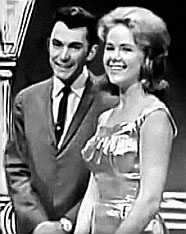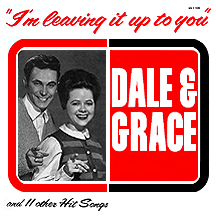DALE AND GRACE
I'm Leaving it Up to You
One of the biggest of all the Louisiana swamp pop records had its start with two singers from Pasadena, California. Though Don Harris and Dewey Terry recorded some great sides for the Specialty label in the late 1950s, not one of them was a hit...at the time. Radio, for some reason, avoided Don and Dewey, but musicians and singers noted the duo's dynamic stage presence and songwriting skills. Over the next few years, "Big Boy Pete" (by The Olympics in 1960), "Farmer John" (The Premiers in '64) and "Justine" (The Righteous Brothers in '65) put the Terry-Harris writing team on the charts, and the biggest of the bunch was a number one hit called "I'm Leaving it Up to You."
The sound of the swamp was never so sweet than when Dale Houston and Grace Broussard got together, yet their best-known songs are of the bittersweet variety. Dale grew up in Baton Rouge, Louisiana, a self-taught piano player with songwriting and performing ambitions. Grace and her brother Van Broussard, from nearby Prairieville, often sang together. Dale was making the rounds at local bars in the early 1960s when Sam Montalbano caught his act and hired him to record for his Baton Rouge-based record company, which had three labels named after Sam's daughters Michelle, Stephanie and Debbie. None of Houston's efforts really connected until Montalbano threw an informal Cajun cookout at his home one day and introduced Grace to Dale.
When Dale and Grace recorded "I'm Leaving it Up to You" in 1963, it was a haphazard affair. Dale didn't know the Don and Dewey song as well as he should have; the original's second verse was replaced by the two singers simply repeating the first. What resulted was essentially a practice take that became the single release. The string section wasn't even playing in the same key the two were singing in, but it mattered little. Montalbano (known to many in the biz as Sam Montel) quickly sent out copies to area radio stations on the Michelle label. The duo's voices were an unrefined but unique blend, and the off-kilter strings served as an enhancement to the emotional energy. The song caught on quickly and Sam rereleased it on his Montel label (with which he had a national distribution deal through Jamie/Guyden). The record's reach went far beyond the bayou country; breaking into the national charts at the beginning of October, it hit number one the week of November 22, 1963.

The excitement of breaking through in such a big way was dampened by the assassination of President John F. Kennedy, in an instance of timing that will always hang like a dark cloud over this particular hit song. An unlikely coincidence brought the tragedy even closer to Dale and Grace. They were performing as part of Dick Clark's Caravan of Stars tour with fellow Baton Rouge native Jimmy Clanton, in addition to Bobby Vee and Brian Hyland. A show was scheduled in Dallas, Texas, the night of November 22, the same day as the President's visit. Early that afternoon they were all present, watching and waving as the motorcade came down Main Street, past their hotel, before turning onto Houston Street. Minutes later, at 12:30PM, the fatal shots were fired as the limousine turned onto Elm Street. Dale, Grace and the others heard the shots but didn't realize until later what had actually happened. That evening's concert was canceled, by the way.
The new year brought a second release, "Stop and Think it Over," written by Jake Graffiano, with an arrangement nearly identical to the first song's but for a two-second pause each time they sang the word "stop." It made the top ten in February 1964. Houston had the added value of writing the B sides for each single, but soon it became clear that Dale and Grace were not getting along, paralleling the soap opera lyrics of their hit songs...without the romance. Add to this an illness that put Dale out of commission for several weeks at a time when they should have kept a high profile, and the team was rapidly falling apart. It didn't help that none of the subsequent releases sold well; staying with the same sound and forlorn theme, as with the third single "The Loneliest Night," it's not surprising. After a few more Michelle/Montel 45s, they went their separate ways in 1965. Dale continued to record and perform solo, while Grace reteamed with her brother. "I'd Rather Be Free," a final single by the duo, written by Dale Houston and released by Hanna-Barbera Records the following year, summed up the relationship.


